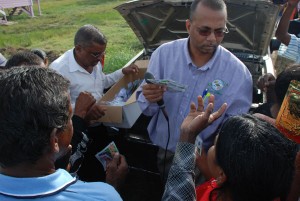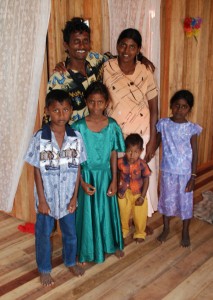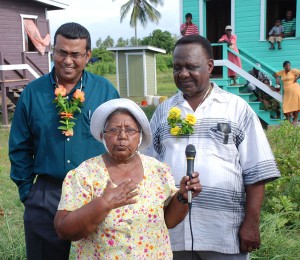By Zoisa Fraser
Residents of two Mahaica River communities, who have over the years been victims of severe flooding, now have a new lease on life after 25 of them received brand new homes and land to continue their way of life.
Following the 2005 floods which affected communities mostly along Guyana’s coastline and after hearing the plight of those living in the Joe Hook and Grass Hook areas, government allocated house lots at Hope Coconut Estate, Mahaica to them free of cost so that they could relocate to avoid the constant flooding.
While a few
The one-flat wooden houses were officially handed over to the residents during a simple ceremony yesterday and while the scheme lacks basic infrastructure such as running water and electricity, residents expressed gratitude and promised to care the structures and do what they can to develop the area.
Each house is outfitted with an outdoor toilet and bathroom.
Further, Food for the Poor has pledged to give the residents a quantity of farming implements which are expected in the country shortly and some seeds. The new Guyana Marketing Corporation (GMC) following the ceremony handed out packets of vegetable seeds to residents so that they too can be a part of the ‘grow more food’ campaign.
While the relocated residents will be allowed to retain their lands in the Mahaica River area, each family has been given five acres of land by the Ministry of Agriculture, who will in time also provide pasturage for cattle rearing.
The land to be given to the residents has already been identified but has to be cleared so that planting can commence.
The Ministry of Housing and Water as well as the National Drainage and Irrigation Board (NDIA) also played a part in bringing some ease to the residents. Pipelines have already been laid but in order to benefit from this, residents will have to pay a connection fee.
Revitalize
Delivering the feature address, Agriculture Minister Robert Persaud recalled that in December last year some of the residents had urged him to help in accelerating the relocation process after they highlighted the cost attached.
He said that some of the residents even suggested the possibility of government contributing towards building residential structures.
According to Persaud, he made contact with Leon Davis, the executive director of Food for the Poor keeping in mind all the work that the organization had done.

He said that each of the households will be given five acres of land to continue their farming activities, while pointing out that residents now have the opportunity to revitalize the estate.
He said that over the years the estate has been at a standstill and several interventions such as crops, livestock and aquaculture were tried but with limited success.
The minister said that the ministry is now looking to work in collaboration with local farmers to revitalize the estate.
He said that they have also looked at external investors and so far one has indicated interest in setting up a commercial type farm in the area.
He described the area as a “gold mine” since it has good land and there is accessibility. Against this backdrop he urged the residents to ensure that they make full use of the lands.
According to Persaud, he wants the farmers in the area to benefit and stressed that the conditions at Hope are much better than in the Mahaica River.

Meanwhile Davis said that the contractor’s efforts were hampered by the weather. He said that when he was contacted by the ministry, consent was readily given to build the homes but the only regret he has is that 25 instead of 40 houses were built.
“All of it is free. All we are asking you is to care it (houses),” he said, adding that $16.5M was spent.
He thanked the contractor for ensuring that the deadline was met. The contractor was so committed to the project that he brought in a pump to pump out some water that was on the land.
While residents have not moved into their new structures as yet, several who were at the handing-over ceremony said they will do so in the coming weeks.
This newspaper noticed one newly-built concrete house and several under construction in the scheme.
Grateful
“I live at Grass Hook, and we always flood out. It always affecting my crops. I am so grateful for this house,” an excited Rukhamini Prasram said.

Kuldoo Oumdat, also of Grass Hook, said that he was happy for the opportunity to be relocated and get a house free of cost.
He said that he plants bora and when he relocates, he will continue planting that crop.
In speaking on behalf of all the residents who benefited from the initiative, Shereen Looknauth extended thanks to Food for the Poor for assisting them to “escape from deplorable conditions we lived in due to flooding.”
She also thanked the government for the free house lots.
Rohani Gopaul, an elderly farmer, and others also extended their thanks to all those who made their relocation possible.
Following the handing-over ceremony, residents of the area raised several concerns with the minister, who urged the old farmers to work with the new ones to ensure the successful development of the area.
Also present were Oudho Homenauth, Director of NARI (National Agricultural Research Institute) and chairman of the Hope Coconut Industries Limited Board; Nizam Hassan, General Manager of the new GMC; Gladwin Charles, Director of Settlements Regulariza-tion and Upgrading Department and officials of the Agriculture Ministry and NARI.





